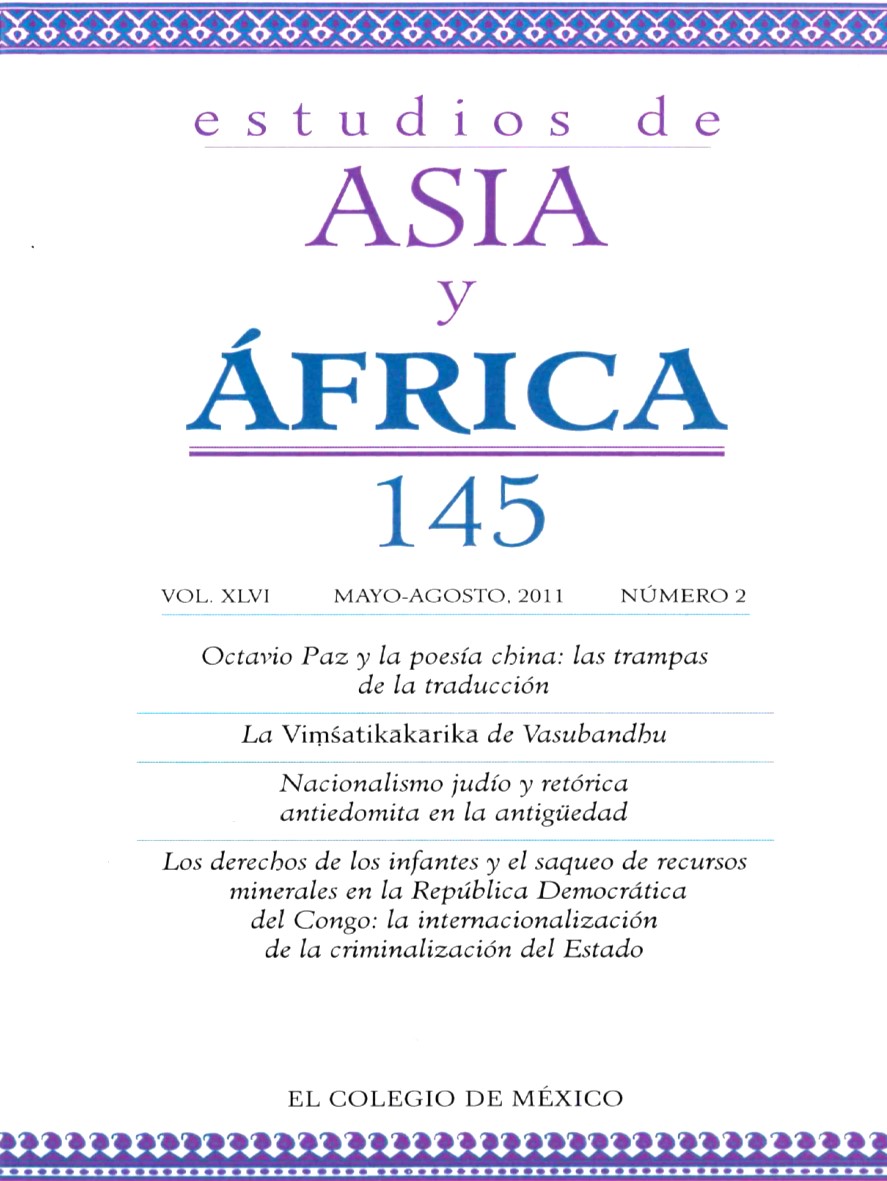Resumen
Este artículo presenta al filósofo budista Vasubandhu, uno de los principales representantes del llamado “idealismo budista”, que floreció en torno del siglo IV de nuestra era y cuyo pensamiento constituye una de las corrientes más influyentes del Mahayana. Se examina una de sus obras, las Veinte estrofas (Viṃ'satikākārikā), y los diversos comentarios, antiguos y modernos, alrededor de ella. El artículo analiza las diferentes interpretaciones que la investigación contemporánea ha hecho de este tratado, que oscila entre la interpretación idealista y la consideración de Vasubandhu como defensor de un “pragmatismo cognitivo”.
Referencias
Anacker, Stefan, Seven Works of Vasubandhu: The Buddhist Psychological Doctor, Delhi, Motilal Banarsidass Publishers, 1998.
Beal, Samuel (ed. y trad.), Si-Yu-Ki. Buddhist Records of the Western World, traducción del chino de Huien Tsiang, Londres, Trubner & Co., 1969.
Chatterjee, Ashok Kumar, The Yogācāra Idealism, Delhi, Motilal Banarsidass, 1987.
Chimpa, Lama y A. Chattopadhyaya (trads.), Taranatha’s History of Buddhism in India, Simla, Indian Institute of Advanced Study, 1970.
Dahlia, Albert A. (trad.), Lives of Great Monks and Nuns, Berkeley, Numata Center for Buddhist Translation and Research, 2006.
Dasgupta, Surendranath: “Philosophy of Vasubandhu in Vimsatika and Trimsika”, The Indian Historical Quarterly, vol. 4. núm. 1, marzo de 1928, pp. 36-43.
De La Vallée Poussin, Louis (ed. y trad. del chino y tibetano), Abhidharmakośabhāśyam, de Vasubandhu, trad. al inglés Leo M. Pruden, Berkeley, Asian Humanities Press, 4 vols., 1988.
Duerlinger, James, Indian Buddhist Theories of Person: Vasubandhu’s Refutation of the Theory of a Self, Londres, Routledge Curzon, 2003.
Fatone, Vicente, Obras completas I. Ensayos sobre hinduismo y budismo, Buenos Aires, Sudamericana, 1972.
Frawallner, Erich, “On the Date of the Buddhist Master of the Law, Vasubandhu”, Serie Orientale, núm. 3, Roma, IsMeo, 1951.
Giles, H. A., The Travels of Fa-hsien (399-414 A.D.), or Record of the Buddhistic Kingdoms, Londres, Routledge & Kegan Paul, 1959.
Gómez, Luis O. (ed. y trad.), “Buddhist Views on Language”, en M. Eliade (ed.), Encyclopedia of Religion, vol. 8, Nueva York, Macmillan, 1985.
____________, “Two Jars on Two Tables. Reflections on the ‘Two Truths’”, en Jonathas A. Silk (ed.), Wisdom, Compassion, and the Search for Understanding. The Buddhist Studies Legacy of Gadjin M. Nagao, Honolulú, University of Hawaii Press, 2000.
Hall, Bruce C., “The Meaning of Vijnapti in Vasubandhu’s Concept of Mind”, Journal of the International Association of Buddhist Studies, núm. 9, 1986, pp. 7-23.
Hamilton, Clarence H., Wei Shih Er Shih Lun, or the Treatise in Twenty Stanzas on Representation-Only, New Haven, American Oriental Society, 1938.
Hattori, Masaaki, Dignāga, On Perception (traducción anotada del primer capítulo del Pramāsasamuccaya), Cambridge, Harvard University Press, 1968.
Jaini, Padmanabh S., “On the Theory of Two Vasubandhus”, Bulletin of the School of Oriental and African Studies, núm. 21, 1958, pp. 48-53.
Kaplan, Stefan, “A Holographic Alternative to a Traditional Yogacara Simile: An Analysis of Vasubandhu’s Trisvabhava Doctrine”, Eastern Buddhist, núm. 23, 1990, pp. 56-78.
Kochumuttom, Thomas, A Buddhist Doctrine of Experience: A New Translation and Interpretation of the Works of Vasubandhu the Yogacarin, Delhi, Motilal Banarsidass, 1982.
Kritzer, Robert, “Vasubandhu on Samapratyaya Vijnanamam”, Journal of the International Association of Buddhist Studies, vol. 16, núm. 1, 1993, pp. 24-55.
Lamotte, Etienne, History of Indian Buddhism, from the Origins to the Śaka Era, trad. Sara Boin-Webb, Louvain, Université du Lou-vain, 1988.
____________, “The Assessment of Textual Interpretation in Buddhism”, trad. Sara Boin-Webb, en Donald S. López (ed.), Buddhist Hermeneutics, Honolulú, University of Hawaii Press, 1988.
Levi, Sylvain, Un système de philosophie bouddhique: Materiaux pour l’étude du système Vijnaptimatra, París, Bibliotheque de l’École des Hautes Études, fasc. 260, 1932.
Lusthaus, Dan, Buddhist Phenomenology: A Philosophical Investigation of Yogacara Buddhism and the Ch’eng wei shih lun, Londres, Curzon, 2000.
Matilal, Bimal Krishna, Epistemology, Logic and Grammar in Indian Philosophical Analysis, The Hague, Moutonm, 1971.
____________, “Mysticism and Reality: Inneffability”, Journal of Indian Philosophy, núm. 3, 1975.
____________, Perception. An Essay on Classical Indian Theories of Knowledge, Oxford, Clarendon Press, 1986.
____________ (ed.), “Buddhist Logic and Epistemology”, Buddhist Logic and Epistemology: Studies in the Buddhist Analysis of Inference and Language, Boston, Reidel, 1986.
Murti, T. R. V., The Central Philosophy of Buddhism, Londres, George Allen & Unwin Ltd., 1955.
Nagao, Gadjin, “The Buddhist Word View as Elucidated in the Three- Nature Theory and its Similes”, Mādhyamika and Yogācāra, Delhi, Sri Satguru Publications, 1992, pp. 61-74.
____________, “What Remains in śunyatā: A Yogācāra Interpretation of Emptiness”, Mādhyamika and Yogācāra, Delhi, Sri Satguru Publications, 1992, pp. 51- 61.
____________, “Yogācāra -A Reppraisal”, Mādhyamika and Yogācāra, Delhi, Sri Satguru Publications, 1992, pp. 219-226.
Nakamura, Hajime, Indian Buddhism: A Survey with Bibliographical Notes, Hirakata, Kufs Publication, 1980.
Obermiller, E. (trad.), The History of Buddhism in India and Tibet by Bu Ston, Delhi, Sri Satguru Publications, 1986.
Potter, Kart H. (ed.), Encyclopedia of Indian Philosophies, vol. 1: Bibliography, Delhi, Motilal Banarsidass, 1983.
____________, Encyclopedia of Indian Philosophies, vol. 4: Sāmkhya, Gerald Larson y Ram Shankar Bhattacharya (eds.), Delhi, Motilal Banarsidass, 1987.
____________, Encyclopedia of Indian Philosophies, vol. 8: Buddhist Philosophies from 100 to 350 A. D., Delhi, Motilal Banarsidass, 1995.
____________, Presuppositions on India’s Philosophies, Delhi, Motilal Banarsidass, 1991.
Pujol, Óscar, Diccionari Sànscrit-Català, Barcelona, Enciclopèdia Catalana, 2005.
Takakusu, J., “A Study of Paramartha’s Life of Vasubandhu and the Date of Vasubandhu”, Journal of the Royal Asiatic Society, 1905, pp. 33-53.
Tola, Fernando y Carmen Dragonetti, Being as Consciousness: Yogācāra Philosophy of Buddhism, Delhi, Motilal Banarsidass, 2004.
____________, El idealismo budista, México, Premiá, 1989.
____________, “The Trisvabhāvakārik of Vasubandhu”, Journal of Indian Philosophy, núm. 11, 1983, pp. 248-266.
Waldron, William S., The Buddhist Unconsciousness: The ālayavijnāna in the Context of Indian Buddhist Thought, Londres, Routledge Curzon, 2003.
Wayman, Alex, “A Defense of Yogācāra Buddhism”, Philosophy East and West, vol. 46, Honolulú, Hawaii University Press, 1996, pp. 447-476.
Wayman, Alex, A Millennium of Buddhist Logic, Delhi, Motilal Banarsidass, 1999.
Yamada, Isshi, “Vijnaptimatrata of Vasubandhu”, Journal of the Royal Asiatic Society, 1977, pp. 158-176.
Esta obra está bajo una licencia internacional Creative Commons Atribución-NoComercial-SinDerivadas 4.0.
Derechos de autor 2022 Estudios de Asia y África


